Please use the following link to download the March 15, 2025 issue of the syəcəb
Author: Kim Kalliber
Chef Pyet DeSpain represents for Native America on Tournament of Champions

By Kalvin Valdillez; photos courtesy of Pyet DeSpain
The season of the brackets is upon us. And though many are filling out their brackets with NCAA basketball teams for March Madness, Food Network viewers are inputting the names of 32 highly respected chefs on theirs. Now in its sixth season, the hour-long reality cooking contest known as the Tournament of Champions brings together both seasoned vets and up and coming chefs for a thrilling and entertaining single-elimination battle.
Not only are the chefs competiting against each other, but they are also up against the ‘randomizer’, which is a wheel that determines the protein, produce, equipment, style, ingredient, and time of their cook. The chefs must incorporate each aspect of the randomizer into their plate or else they face disqualification. The dishes are then subject to a blind judging process, where their food is placed in front of a panel of top tier chefs who do not know whose meal they are judging. The competitors must watch the judging process from their trailers and are called back to the stage once the results are in. The winner advances in the bracket until only one chef remains victorious and is awarded a cash prize, bragging rights, and the highly coveted TOC championship belt.
Split into four divisions, 24 well-known chefs were invited to the tournament and were seeded based on their accolades and accomplishments in the culinary world. The remaining eight spots had to be earned in the qualifier round, where 16 rising stars duked it out and put their all on a plate in hopes of advancing to the big dance. Among these 16 competitors was none other than Chef Stephanie ‘Pyet’ DeSpain of the Prairie Band Potawatomi Nation.
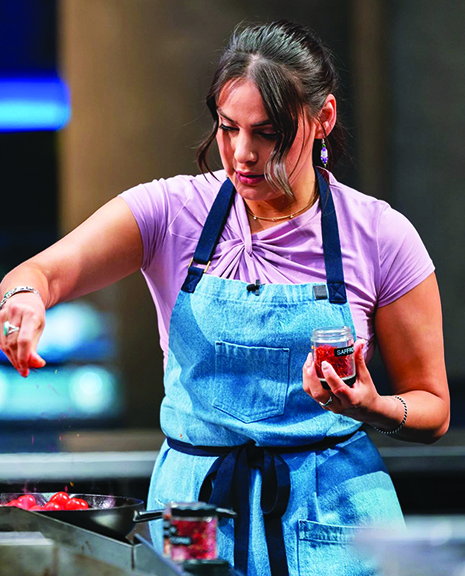
If you aren’t familiar with her game, Chef Pyet won the very first season of Gordon Ramsay’s Next Level Chef competition in 2022. Throughout Next Level Chef she incorporated her Native American and Mexican heritage into each dish she put forward. And by doing so, she brought some Indigenous teachings, knowledge, and history into living rooms all across the country.
Since winning Next Level Chef, Pyet has expanded her Los Angeles-based business, Pyet’s Plate, and has been named one of the Top 25 private chefs by Entrepreneur Magazine. In addition to offering her services as a private chef and catering at high-profile events, she also takes time to teach cooking classes and utilizes her platform to inspire Native youth throughout the nation. This is something she is very passionate about. In fact, she was the keynote speaker at 2022 UNITY conference in Minneapolis.
Hoping to inspire the next generation at the conference, Pyet shared “Remember that it’s okay to be your true authentic self. It’s okay to show the world you’re brown and proud. It’s okay to take a risk. Even if it might look scary, you never know where it leads you. Most importantly, it’s so crucial that you don’t forget your roots and you don’t forget your ways. Every day from this point forward, when you wake up, I want to challenge you to ask yourself, ‘who do I want to be?’. Not just in the future, but who do you want to be today. Do you want to be the best daughter? The best brother or sister? Do you want to be the best version of yourself? Really think about it because that’s what’s called setting an intention. When you start showing up as your best self every single day, and you’re brown and proud, things will start falling into place for you.”
This was Chef Pyet’s second year participating in the qualifying round. After she didn’t make the cut last year, she was determined to come back stronger than ever. And judging by the focus and energy she brought this year; she is not playing around and is gunning for the championship belt. She faced-off against Chef Ashleigh Shanti, who is a James Beard finalist and was named one of ‘16 Black Chefs Changing Food in America’ by the New York Times in 2019. In this round the randomizer called for a dish that consisted of ground beef, cherry tomatoes, and a peppery profile. She also had to incorporate the use of a spiralizer and had only 28 minutes to cook. In the end, Pyet’s Persian-inspired koobideh beat out Chef Ashleigh’s Salisbury steak by a margin of seven points.
After winning her qualifying round, TOC host and creator Guy Fieri said, “You wanted the tournament. This is your shot! You just won. Congratulations Chef DeSpain.”
Now in the main bracket, she must continue to bring her A-game as she goes head-to-head against some of the biggest names in the industry, including two Seattle-based restauranters, Shota Nakajima and Kaleena Bliss.

Said Chef Pyet, “You don’t see a lot of Native American chefs in cooking competitions – I might be the only one and that’s a big deal. I don’t work in a restaurant; I’m a private chef. That is the one thing that can be a little bit of a disadvantage. A lot of these other chefs got years and years of restaurant work under their belt, but Pyet is here and she’s staying in the tournament, she’s staying in the bracket.”
Her biggest challenge of the competition may perhaps come in the first round where she will take on a frequent TOC finalist and well-established chef, Jet Tila.
On an Instagram post she stated, “Going toe-to-toe with the legendary Jet Tila was not on my bingo card for 2025 life events, but here we are!”
Chef Pyet will make her first appearance on Tournament of Champions this Sunday, March 16. The show airs at 8:00 p.m. on the Food Network channel. You can stream the episode on Max or Hulu the day after it airs, beginning at midnight on March 17. Be sure to tune in to cheer on Chef Pyet as she continues to represent for Native America on the biggest stage in culinary competitions.
“I feel amazing. I’m very happy. I’m very excited,” she expressed. “I’m here for all the young Native people that aspire to be chefs, I’m here to fight for them.”
Elishia Stewart’s homemade jam part of General Council gifts
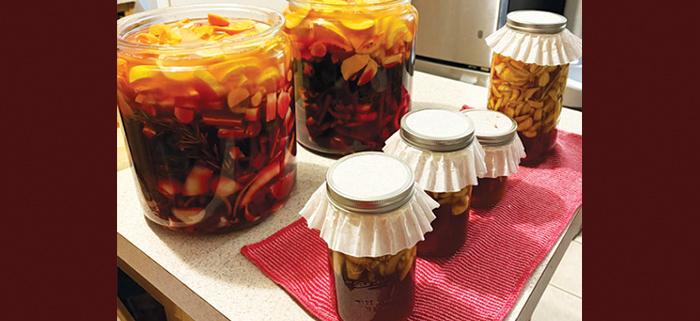
By Wade Sheldon; photos courtesy of Elishia Stewart.
The upcoming General Council meeting on April 12 at the Tulalip Resort Casino is set to showcase the creativity and talents of tribal members through thoughtful gifts. These gifts include an array of delicious jams from local entrepreneur Elishia Stewart and her business, Wicked Jamz and More.
Elishia reflects on turning her passion for canning into a thriving business, stating, “I’ve been canning foods my whole life, off and on. As a kid, my mom taught my siblings and me how to can fruits and vegetables. She always made freezer jam, but I make shelf-stable jam because I don’t want to use freezer space. After making some for my nieces and nephews, I thought maybe I should turn this into a business.”
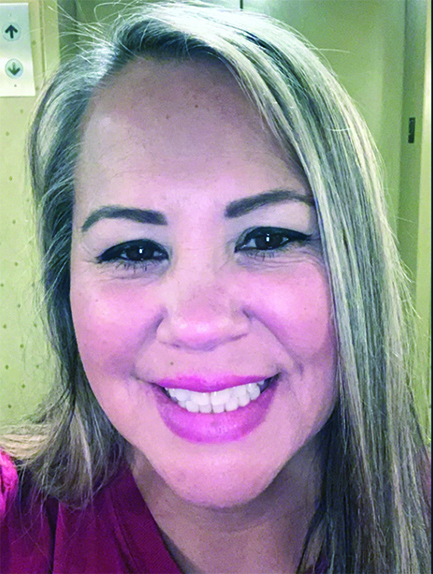
Elishia enjoys this process as a form of meditation. She describes it as follows: “I do it because I like it. Everybody has their own thing they do for meditation or therapy. Creating jam is meditative; it allows me to zone out and focus while shutting everything else out. It’s nice.”
She emphasizes the importance of quality in her ingredients, sharing her philosophy about crafting jams. Elishia noted, “The quality of the fruit is essential. Be selective about the combinations that you use in your jams. One of the things that I did that my mom didn’t do was make the jalapeno flavors. My favorite is raspberry jalapeno.”
She explained the selections made for the General Council gift: “The six flavors chosen are blackberry, strawberry, mixed berry, mango jalapeno, raspberry jalapeno, and straight jalapeno. I have 15 different jams, and those are the six that they picked.”
Reflecting on her significant order of 1200 jars of jam for the upcoming General Council meeting, Elishia, said, “I saw the bid and thought, they aren’t asking for snack food. But everybody’s art is different; I don’t carve or create paintings. I showed them this is what I do, and my bid was accepted. I laughed and thought, oh wow, here we are, let’s do this.”
“Having the recipes down to a science helps me ramp up production,” she continued. “Time management has been crucial. I also have a good vendor that lets me buy in bulk. Ensuring a plentiful and efficient supply chain has been vital to reducing stress.”
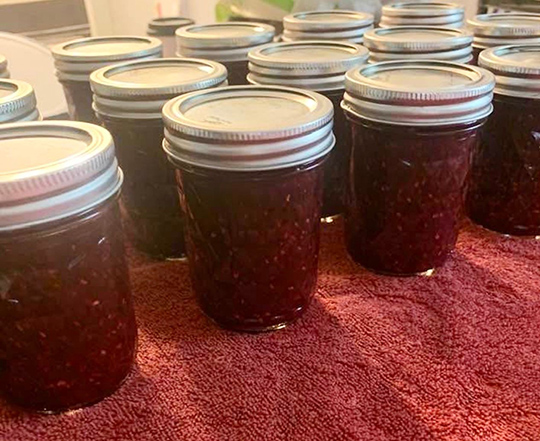
Santana Sheldon, Executive Office Director for the Board of Directors, talked about the initiative of gifting tribal member-crafted items, stating, “We aimed to highlight the artist’s work and reaffirm our connection to our culture and way of life. The 1855 Treaty of Point Elliot will be included inside the box, providing important context when members take out the items.”
She outlined the logistics, stating that 1200 boxes would be available as a thank-you gift for tribal members who come to vote. Each box will include an item from everyone contributing gifts for the General Counsel meeting and will be distributed on a first-come, first-served basis. “This gift serves as appreciation for their engagement by attending the meeting.”
Still to come in this six-part artist series are Walter Moses’s Cedar Clappers, a beautifully crafted musical instrument that resonates with harmony; Jen Tracy’s orca paintings, which capture the grace and power of these magnificent creatures; and Bibianna Ancheta’s homemade chapstick, made with natural ingredients to keep lips soft and hydrated.
If you want to try Elishia’s jam but cannot make it to the General Council meeting, you can reach out to her via Facebook by searching for Elishia Stewart.
Heritage Hawks show out at State. Make history with 4th place finish
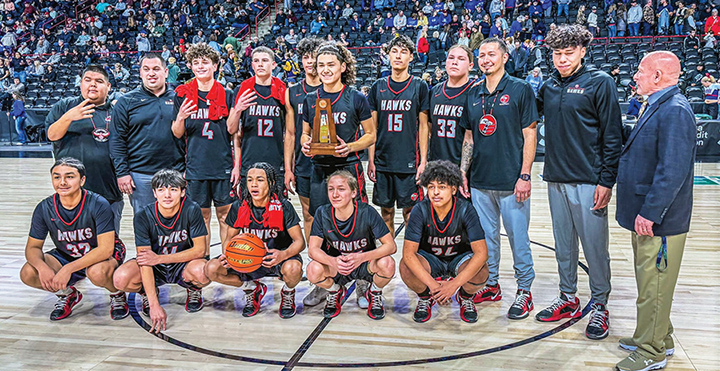
By Micheal Rios, photos courtesy Willy Enick and Deyamonta Diaz
Four games in four days. Under the bright lights of Spokane Arena. For a chance at bucket-getting glory. That was the mission for the (19-4) Tulalip Heritage Hawks boys basketball team who journeyed to Spokane, Washington for the much-heralded WIAA State Tournament.
After an exhilarating (15-1) regular season, 2nd place finish at District’s, and a 3rd place finish at Tri-District’s, the Hawks winning ways earned them a ticket to State. They were slotted as the tournament’s #6 seed.
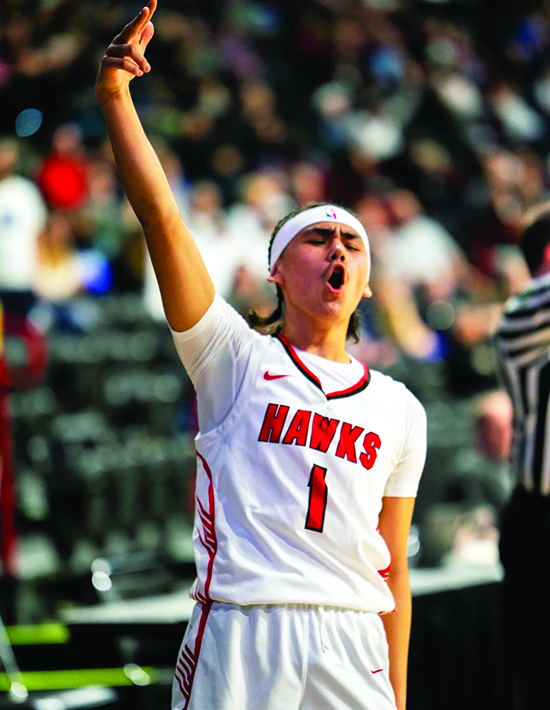
Wednesday, March 5
In Spokane, Tulalip’s first opponent was #14 Summit Classical Christian. They boys previously played and defeated Summit, 66-53, in the Tri-District Tournament. That familiarity with a previously vanquished foe injected additional confidence into an already confident squad. The Hawks jumped out to an early 19-11 1st quarter lead thanks to a well-balanced scoring attack. Each member of the starting lineup scored a basket by the end of the opening quarter.
Their tenacity didn’t let up. The Hawks flew away with a 70-51 win. This particular game was a great example of ball movement and scoring distribution, exemplified by the well-rounded scoring attack. Davien 19 points, Davis 14 points, J.J. 13 points, Ziggy 12 points and Amare 8 points.

Thursday, March 6
The following afternoon, Tulalip faced off with #4 DeSales Catholic out of Walla Walla. Entering the game with a whopping (24-2) record, DeSales proved they were every bit as good as their 24 wins said they were.
Heritage held tough in the 1st quarter, where they only trailed by 3 points, 13-16, after eight minutes of play. But over the course of the 2nd and 3rd quarters, DeSales continued to outscore and outexecute the Hawks. Entering the 4th quarter, Tulalip trailed 38-54.
The 3-ball wasn’t falling for any Hawk outside of Davien, who made 3 of them, and made it impossible to rally enough points for a proper comeback attempt. The Hawks wings got clipped to the tune of a 51-68 loss. Davien led all scorers with 29 points and Ziggy chipped in 10 points.
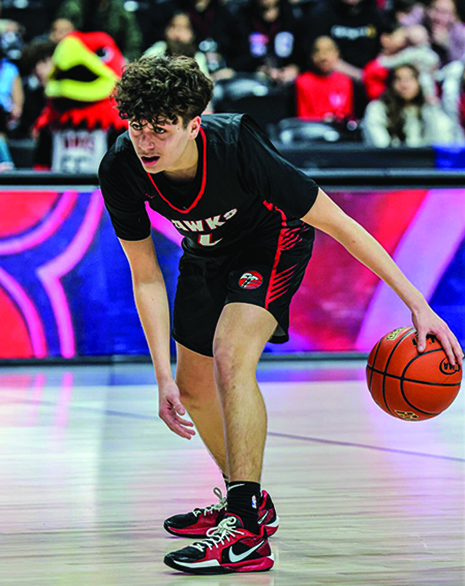
Friday, March 7
Tulalip was left with no other choice but to shake off the previous day’s loss with the quickness because they had an early day tip-off with #7 Moses Lake Christian. Embodying the shooter’s mindset to the fullest was sophomore Amare Hatch. He went scoreless vs. DeSales, but in a matter of minutes he made she he got into the scorer’s book this game. Amare drained back-to-back 3-pointers that helped ignite his team’s early offense. Heritage took a 19-11 lead after one quarter of play.
Moses Lake wasn’t going to go away without a fight thought. They came back with a 2nd quarter onslaught that caught Tulalip off guard. Heritage trailed 26-29 at halftime.
In the 2nd half, it was a pair of sophomore sensations, J.J. Gray and Ziggy Myles-Gilford, who caught fire when their team needed them most. Both boys combined to score 32 of their team’s 41 2nd half points and helped propel their Hawks to a 67-54 win.
J.J. led the Hawks in scoring with 25 points, while Davien added 17 points and Ziggy 13 points. The fight and determination by the Hawks to continue their postseason journey is exemplified by a dominant 4th quarter in which they nearly scored twice as many points as Moses Lake.
The must-have win elevated the Hawks into the 4th place game.

Saturday, March 8
Tulalip’s favorite team of Rez ballers rose shortly after a sunrise for their final game of the ’24-’25 season. Tipping off promptly at 9:30am with a matchup with #3 Willapa Valley was no problem for a team full of young legs and a supply of seemingly endless energy.
It’s important to note that Heritage lost to Willapa Valley just eight days earlier, 53-66, in Chehalis. With that loss still fresh in their minds, the Hawks were primed for a classic get-back game.
In the 1st quarter, all five starters scored a basket. Coming off the bench, junior Tokala Black Tomahawk got in on the scoring spree as well to help his team jump out to a 20-15 lead. Both teams scored exactly 12 points in the 2nd quarter. This gave Heritage a 32-27 halftime advantage.
Forward Ziggy Myles-Gilford put on a show in the 3rd quarter while gobbling up rebounds and powering his way to the bucket for big time layups. Heritage’s defense put the clamps on all would-be scorers, playing some of their best discipled defense of the season. Willapa Valley only mustered a measly 6 points in the 3rd quarter, while the Hawks were soaring at their accustomed tempo and scored 18 points. At the end of three, Tulalip held a commanding 50-33 lead.
With their defense remaining locked in, Tulalip quelled any notion of a Willapa Valley comeback. While welcomed chants of “Tulalip Power!” rained down upon them, the boys were all smiles as they basked in a 64-46 victory. They capped off a truly memorable (22-5) season with a 4th place clinching performance to be proud of. Ziggy led all scorers with 17 points, J.J. 14 points, Davien 11 points and Davis 10 points.
After the tournament’s conclusion, junior guard Davien Parks was awarded one of the five coveted spots on the All-Tournament team.
“Our four days at state this year was great for my boys,” reflected head coach Shawn Sanchey. “We had fun out there doing our thing, gaining experience and going to battle in the Spokane Arena. Our team represented well and earned their hardware. We took home fourth place, which lands the second best placing in school history!
“It was tough not reaching the goal of winning it all, but we adjusted to the circumstances and set a new goal,” he continued. “It’s a great feeling that they buckled down to take care of business and bring home the 4th place trophy. This State experience builds character for us and deepens the motivation to do what it takes to reach that final goal next year. We plan to get a busy off-season summer schedule doing trainings, weight lifting, leagues and tournaments to help elevate our program and take it to the next level.”
For those devout Heritage fans already looking forward to next year, all the Hawks core players are expected to return, including all 5 starters. With a full State experience now under their belts and another year of program building for the Heritage coaching staff, expectations in 2026 will be even higher for a soaring group of Hawks who etched their names into school history with a 4th place trophy.
MSD celebrates culture and community through round dance
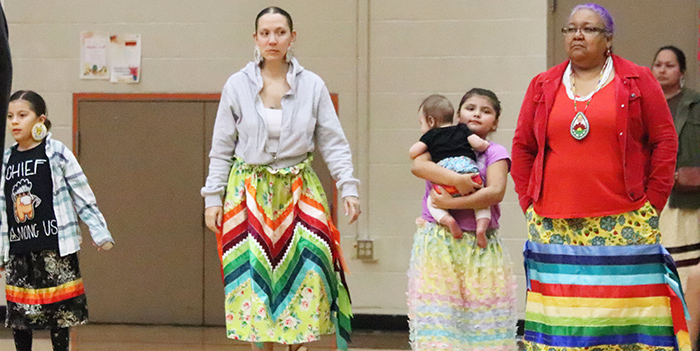
By Wade Sheldon, Tulalip News
Totem Middle School hosted its annual Round Dance on Thursday, March 6. This vibrant celebration not only united members of the Native American community but also showcased their rich cultural heritage through traditional songs and dances. The gathering invites students and families from the (MSD) Marysville School District to engage with Native traditions. Over 60 attendees enjoyed a variety of food while taking part in the round dance held in the gymnasium.
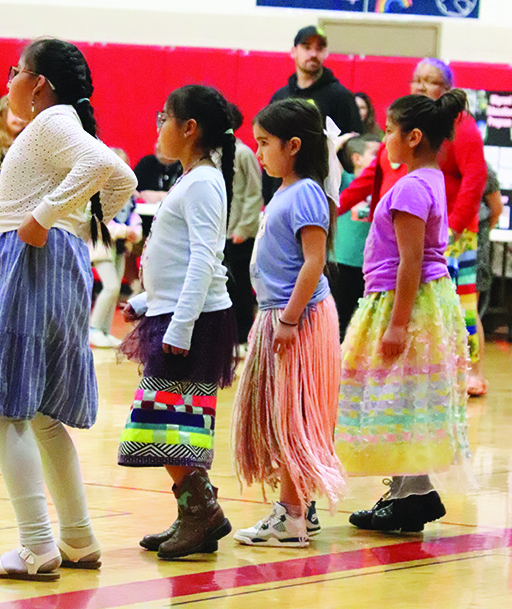
Often held during winter, the round dance promotes healing, celebrates life, and represents the interconnectedness of everything. Initially said to have been started by the Plains Indians, this tradition soon spread throughout Indian country. During the dance, drummers play in the center of the room while the dancers circle them clockwise. Each group of drummers performs four songs, followed by another group singing four songs to represent the four seasons.
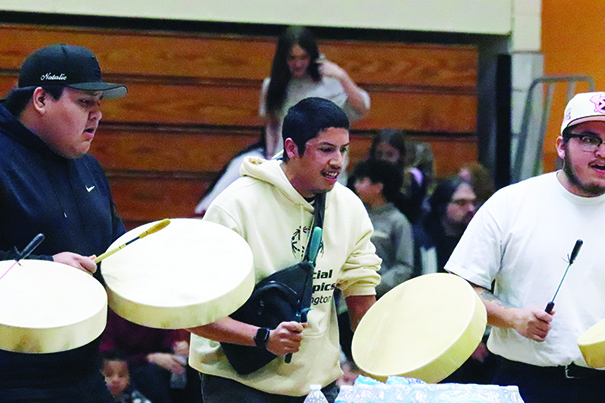
Although the event was not crowded, participants eagerly embraced the dance floor and immersed themselves in the festivities. Terrance Sabbas, MSD Native American Liason, commented, “Round Dance is an annual event we host in collaboration with Native education, the Marysville School District, Tulalip youth advocates, and Totem Middle School. The vision when I started this round dance was to create unity between our people, district staff, and the community. To come together, enjoy our way of life, indulge in good food, and have a good time. In today’s uncertain times, I want people to connect. I want non-Natives to know us better and for our Native peoples to be around their relatives.”
Sabbas describes the round dance as a means of healing, noting, “When we share in this way, it heals us. Through this round dance, we can enjoy one another and our way of life deeply. This gathering provides comfort through togetherness.”
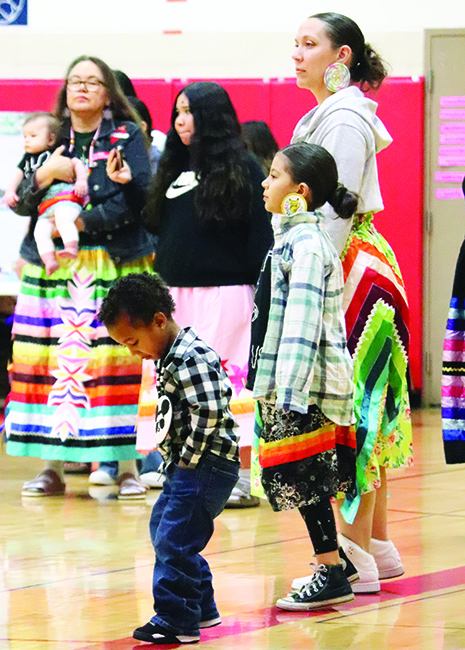
Emmarie Davis, a member of the Tulalip tribe, shared, “This is my first time coming. I had a great time dancing. It’s important to keep tradition alive, to be with our community, and to remember our old ways while spreading our culture to those who may have lost theirs or want to feel closer to the community.”
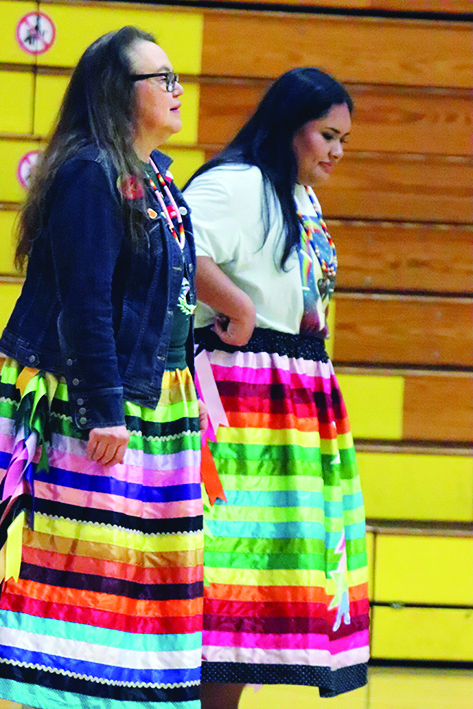
The Round Dance at Totem Middle School achieved its purpose: It created an inviting space for everyone to revel in a joyful evening filled with laughter, connection, and community spirit. Attendees left with warm hearts and cherished memories, eagerly anticipating the next time they can gather.
Robert September Fryberg

Robert Fryberg, 41 of Tulalip Tribes was born September 9, 1983 to Audrey “Odder” Fryberg and Michael Denunzio. He went on his journey March 4, 2025.
An interfaith service will be held Monday, March 10, 2025 at 6 PM at the Tulalip Gathering Hall. Funeral Services will be held Tuesday, March 11, 2025 at 10 AM at the Tulalip Gathering Hall with burial to follow at the Mission Beach Cemetery.
Tah-Sheena Shantel Judith Williams

Sunrise, December 10, 1987, Everett, Washington & Sunset, March 2, 2025, Tulalip, Washington
Beloved daughter, mother Tah-Sheena Shantel Judith Williams, 37, left us to be with the Lord in Heaven and is now resting in peace with mother Rose Buck Williams & grandmother Helen Campbell. Father, Raymond E. Madrid, resides in Tulalip, Washington.
Special Godmothers include: Judith Patrick and Wendy Church
Tah-Sheena also leaves behind her beautiful daughters that she loved very much Tyra Williams, Nakala Williams Cultee, Adriana Williams, Amelia Williams and, in passing, daughter Evelyn Cultee.
She also leaves behind loving husband, Michael Laramie. Her siblings include Fawn Madrid, Ray Madrid, Jr. Michael Madrid and Jerry Williams.
Tah-Sheena “Sheena” loved her grandmother, Helen Campbell (who passed in 2020); and, also loved her family-especially her children. She will forever be missed and always loved with the legacy of an eternal flame.
“The world used to be so vibrant & bright; the world lost a little color today.” Tyra Williams
Funeral Service will be held Friday, March 7, 2025 at 10:00 a.m. at the Tulalip Gathering Hall, 7512 Totem Beach Rd., Tulalip, WA 98271 with burial to follow at Mission Beach Cemetery.
March 8, 2025 syəcəb
Please use the following link to download the March 8, 2025 issue of the syəcəb
Recovery is possible, no one has to walk the path alone
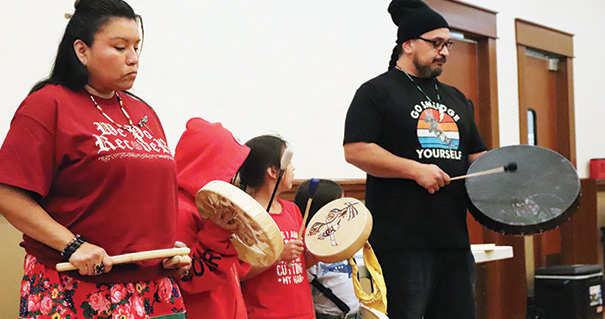
By Wade Sheldon, Tulalip News
Wellbriety is a transformative program dedicated to supporting Native communities in their journey toward addiction recovery. Integrating cultural traditions and holistic practices fosters reconnection among individuals and their communities, providing a nurturing environment that promotes healing beyond traditional twelve-step frameworks. The program emphasizes balance and harmony through methods like the medicine wheel, allowing participants to acknowledge their progress and manage their urges as they strive for a brighter future.
On February 20, Wellbriety hosted its third annual dinner at the Tulalip Dining Hall. Around 50 attendees celebrated this ongoing journey. The event highlighted the profound impacts of addiction on Native communities and the strides being made toward liberation.
As many Native communities have faced the painful legacies of addiction, Wellbriety has emerged as a beacon of hope. Its efforts, revitalized in 2023 in collaboration with Tulalip’s Family Services and Problem Gambling Program, assist individuals in finding the Red Road to recovery. During the dinner, Robin Johnson, a Chemical Dependency Professional, and Katy Berry, a Substance Use Disorder Professional from Tulalip Behavioral Health, facilitated a space for attendees to share their personal stories, illustrating how culture can serve as powerful medicine in reclaiming lives from despair.
The evening underscored that hope and healing are possible, even in the face of daunting challenges, reinforcing the importance of community and cultural identity in the recovery journey. Attendees recounted their distinct paths to sobriety—or should we say, Wellbriety. The journey looks different for each participant.
Israel (Scott) Rehaume, a Yakima Native with 13 years of sobriety, faced a difficult upbringing that led to destructive adult behaviors. After encountering the law, he realized the need for change.
For many, overcoming addiction is not just about abstinence; it’s about transformation and purpose. Israel reflects on his arduous journey with a determination to change. He aims to be the role model he always needed as a child. Rehaume shared, “It’s been a long road since my addiction started, and today, I strive to be the person I wish I had been then. Alcohol and drugs are slow suicide.”
His addiction began at six, bringing drinks to his father and his friends. “I thought my dad was a superhero, and that’s where it all began. I was allowed to drink at twelve, which eventually fueled my addiction with violence. We would get drunk and fight. Soon, I was drinking at school and was expelled at seventeen. I was living a hectic life filled with meth, and while it felt normal, it wasn’t.”
His turning point came after being shot in a drive-by. He also faced consequences for breaking and entering, which led to his first treatment sentence. During this time, he stayed clean for eight months before relapsing. Rehaume would finally achieve sobriety after being caught with a firearm and sentenced to prison. “When I got out, I didn’t let anything interfere with my sobriety. When I had my son, I wanted to ensure he was raised right,” Rehaume recounted.
He stressed, “I do everything I can to help the community because I spent so much time peer-pressuring people into dope; now it’s time to peer-pressure them into getting clean.”
Rehaume encouraged community support, saying, “If you get enough people to lean on, then you won’t fall.” He believes that “sobriety and wellness are key.”
Lonni Long also shared her journey, revealing, “When I was 18, I knew I was an alcoholic. I thought I was going to die but didn’t want to do anything to change it.”
Lonni’s childhood was tumultuous, marked by the loss of her mother at ten and living with relatives. She recalled, “Growing up, I had to live with my relatives. From ages 8 to 12, I faced a lot of abuse, both sexually and emotionally. I started acting out at 13 to 14, drinking, smoking, and getting involved with gangs.
Despite attempts at recovery at ages 16 and 18, Lonni struggled with addiction, reflecting, “At first, it would work. I knew I wanted to do better, but alcohol made me feel happy.” At age 17, her sister’s sudden and tragic death plunged her into more profound grief, where she noted, “I became selfish and self-centered. That’s when I started using drugs. I began smoking meth and continued for 15 years straight.”
Lonni’s life spiraled into chaos: “I lost track of the constructs of time. Time didn’t mean anything to me.” After multiple DUIs and a period of not trusting anyone, she discovered she was pregnant. “I couldn’t change my life for myself. When my baby was born, it was like magic. He made me want to be better and to be clean and sober, which I never thought I could be.” After nine years of sobriety, Lonni emphasized, “This is just the beginning.”
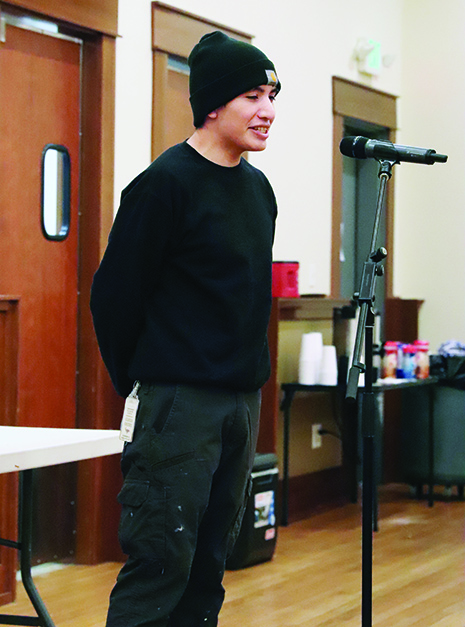
Victor Garcia, a member of the Upper Skagit Tribe, reflected on his journey, saying, “It’s crazy to be coming to events and meetings. A year ago, I was in a dark place. I didn’t have anyone in my corner. It wasn’t until I met the people of Tulalip that I felt actual kindness and love. A few elders would tell me they had prayed and lit a candle for me. They would say they were thinking of me and praying for me. That was an encouraging thing to hear.”
It took a while for Garcia to find his footing as he struggled with active addiction for 12 years. However, he found positivity at the Wellbriety meetings, which he described as a source of great strength. “There’s a lot of good medicine,” he explained. Garcia noted how he saw people who were once on the streets with him, now doing better. He appreciates the program’s many supportive resources, stating that they equip participants with essential tools for maintaining sobriety.
The event closed with a powerful reminder of the strength found in unity with a countdown of sober time. Together, attendees celebrated an impressive collective total of 177.8 years of sobriety. Stories of hardship and healing echoed a shared truth: recovery is possible, and no one has to walk the path alone.
For those seeking support, Wellbriety offers weekly meetings at the Tulalip Dining Hall every Friday at noon, with additional sessions at Behavioral Health Services.
The next opportunity to connect is the annual Problem Gambling Awareness Community Dinner on March 15. Those interested in attending can RSVP at (360) 716-4400.
Salish Art Designs X Starbucks Collaboration
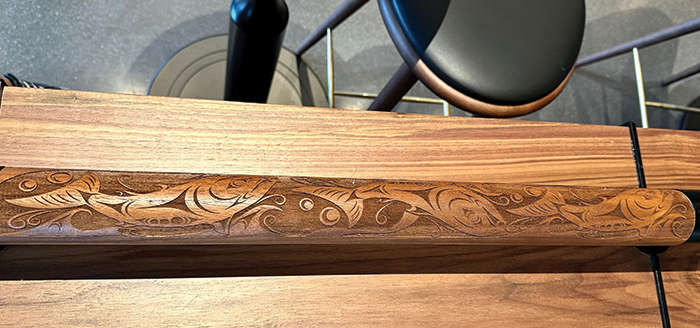
By Kalvin Valdillez, Tulalip News
Located in the heart of the U Village shopping center is a coffee spot that has withstood the test of time. Originally opening its doors in 1972, this shop has seen many businesses come and go as the U Village has gradually grown into the high-end retail mecca that it is known as today. Nowadays, you’d be hard-pressed to not find a Starbucks within a 5-mile radius of any given location. But back then, this was the only Starbucks in the entire world, aside from the flagship store in Pike Place Market, which opened 60 years prior in 1912.
The second Starbucks to ever exist has received a couple of renovations throughout the years, in 1994 and once again in 2009. Most recently, the establishment decided to feature local artwork at the historic location, enlisting three Seattle artists to work on designs for the building’s exterior. And with a desire to incorporate traditional art from a local tribal artist, Starbucks also reached out to Tulalip’s own Walter Moses for a project inside the store.
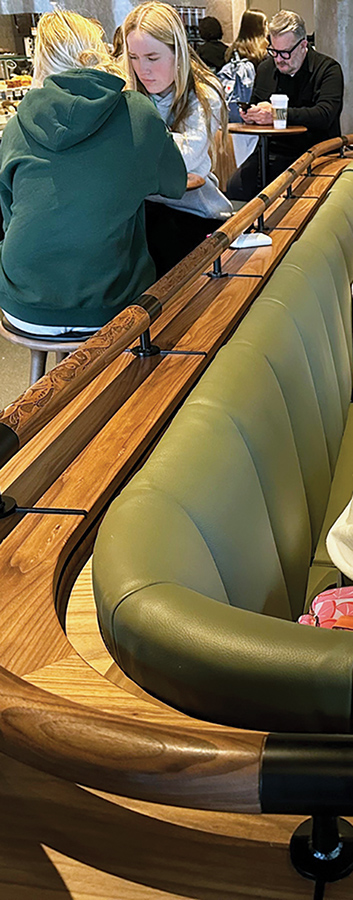
“I just finished up my project with the Starbucks in the U Village,” exclaimed Walter. “One day I was checking my e-mails, and I got a random e-mail from somebody at Starbucks. I’m not sure how, but they got my info and said we would like you to do some designs for us, are you interested? And I was like, ‘uh, yeah!’.”
There is a significant amount of foot traffic in this particular Starbucks by shoppers who need a little extra boost as they check out the dozens of retailers in the village. The lounge is often filled to capacity by local UW students who enjoy a grande or venti sized beverage while they actively work toward their degree. Which of course means that there are many eyes that are constantly drawn to Walter’s work each and every day.
Said Walter, “It’s exciting because I get to leave something behind. They actually had a theme in mind, which was water. Being that it’s in the Pacific Northwest and next to the Puget Sound, they wanted to encompass some kind of water into the design. I told them, ‘Hey, good news because you know, we’re like thee water people. Because we eat salmon, we’re fishermen, and we live by the water. So, this is right up my alley,’.”
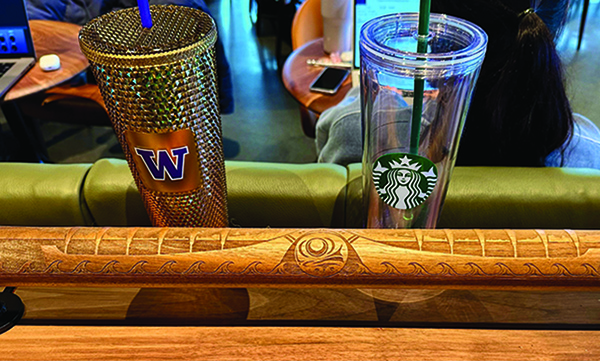
Upon entry to the store, customers are welcome to hop in line to place an order or find a space to take a seat in their lounge. Splitting the floor into those two areas is a partition in which one side features booth-style seating for the lounge. On the other side there are a number of high-top tables. Sitting directly on top of this partition, that aesthetically curves throughout the store, is a wooden rail. And this is where Walter’s designs are showcased.
“I did a salmon design, the salmon are spawning and going up a stream, and there are little salmon eggs around it. Another one I did were otters, because the otters are part of the water, and I think the design looks pretty cool. The otter is swimming on his back and holding a clam. The other one is two killer whales, and I did that because it’s a symbol of our Tribe. And I also did canoes with paddles in them, and there’s a salmon egg in the middle. It’s like the canoes are on the water and you can see the islands in the background.”
Last time Tulalip News caught up with Walter was during the pandemic as he was launching his business Salish Art Designs. This was highly anticipated at the time due to the rise in popularity of his cedar carved earrings. Since then, he has continued to expand that business and opened up an Etsy page to feature his items for sale and reach more potential buyers.
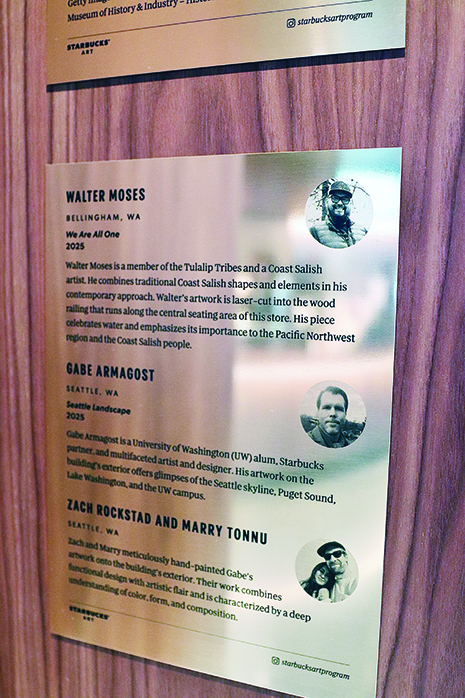
Originally, all of Walter’s earrings were hand painted onto cedar scraps that he salvaged from his job at a lumber mill. However, once he was featured in the syəcəb he began to receive an overwhelming amount of orders, requests, and inquires for the earrings. This is when he started looking into laser engraving machines to help streamline the process and keep up with the demand of his clientele.
Walter shared that he lives by a ‘keep your hands busy’ philosophy, so once he got the Etsy page up and running, he felt it was time to take his jewelry designs to the next level. By learning how to operate the Adobe Illustrator and Procreate software systems, Walter was able to elevate his art and utilize the latest technology and equipment, like laser engraving machines, to bring traditional artwork into modern day projects, such as the Starbucks railing.
He stated, “To me, it’s important that I utilize any and all ways to create art. Whether it’s drawing on a notepad, watercolor, painting, carving. I use printers as well as a photo printer. And I essentially use it to forward the the cultural awareness of art. There’s some skepticism. There are people who are critical of how I do some type of art. Some people criticize using laser machines. I’ve always been called out by a lot of artists and people who say why don’t you do traditional – why don’t you use like rock and stones? And it’s like, no. We use chainsaws and if chainsaws were available at the time our ancestors were alive, they’d be using them too.
“I’ve always been a techie guy since I was a kid. I was there at the dawn of computers, word processing, and typewriters. I was there when all that started kicking off. I’ve always been into electronics and video games, taking apart like radios and stuff and putting them back together. Using software is something that’s like a natural thing to me.”
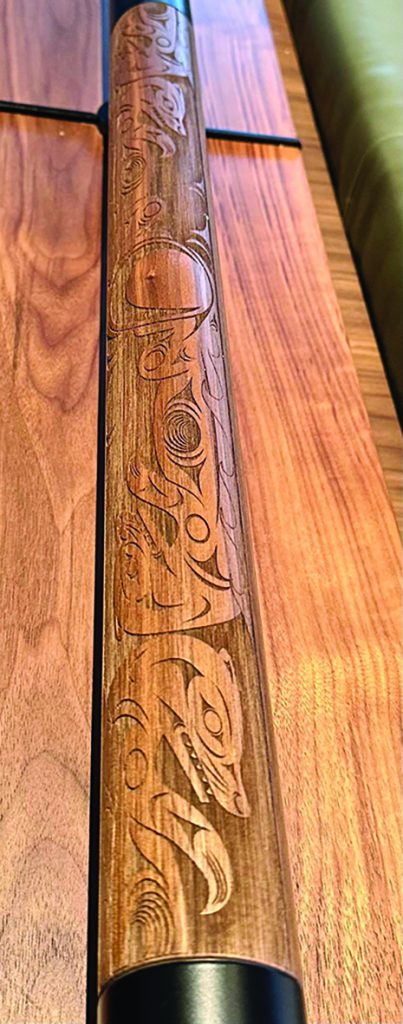
As a Tulalip artist, Walter is very proud of continuing his family’s legacy in traditional art. He shared that his father, Master Carver Kelly Moses Sr., taught, encouraged, and inspired him to be the best artist he could be from an early age. Walter expressed a tremendous amount of joy in the work he did in the Tribal Designs department, a position he held for 14 months, but ultimately had to give up due to the strenuous daily commute from Bellingham to Tulalip. He stated that one of the best parts of that position was visiting Heritage High to pass on his knowledge and work on projects with the students.
“Our art is a visual way of telling stories,” he explained. “I don’t recollect us having a written language. The art was a way to tell a story and it’s an expression of self and family history. A lot of the stuff I do has some of the old traditional stories incorporated into them, but it also has modern stories, things that I’ve gone through, and my family has gone through. And also, just very important values.”
Next time you find yourself in the Seattle area, be sure take a trip to U Village to see his artwork in person. If you are interested in checking out some of Walter’s additional works, you can follow his Instagram page, @WalterMoses_Art. And to purchase his popular and beautiful jewelry, please visit his Etsy page, Salish Art Designs.